正则表达式检测电子邮件
深层学习计划 (DEEP LEARNING PROJECT)
Have you ever wondered how a machine translates language? Or how voice assistants respond to questions? Or how mail gets automatically classified into spam or not spam?
您是否想过机器如何翻译语言? 还是语音助手如何回答问题? 或者如何将邮件自动分类为垃圾邮件?
All these tasks are done through Natural Language Processing (NLP), which processes text into useful insights that can be applied to future data. In the field of artificial intelligence, NLP is one of the most complex areas of research due to the fact that text data is contextual. It needs modification to make it machine-interpretable and requires multiple stages of processing for feature extraction.
所有这些任务都通过自然语言处理(NLP)完成,该处理将文本处理为有用的见解 , 这些见解可应用于将来的数据。 在人工智能领域,由于文本数据是上下文相关的,因此NLP是最复杂的研究领域之一。 它需要进行修改以使其可以机器解释,并且需要多个处理阶段才能进行特征提取。
Classification problems can be broadly split into two categories: binary classification problems, and multi-class classification problems. Binary classification means there are only two possible label classes, e.g. a patient’s condition is cancerous or it isn’t, or a financial transaction is fraudulent or it is not. Multi-class classification refers to cases where there are more than two label classes. An example of this is classifying the sentiment of a movie review into positive, negative, or neutral.
分类问题可以大致分为两类:二元分类问题和多分类问题。 二进制分类意味着只有两种可能的标签类别,例如,患者的状况是癌变还是不是癌变,或者金融交易是否是欺诈性或不是。 多类别分类是指标签类别超过两个的情况。 例如,将电影评论的情绪分为正面,负面或中性。
There are many types of NLP problems, and one of the most common types is the classification of strings. Examples of this include the classification of movies/news articles into different genres and the automated classification of emails into a spam or not spam. I’ll be looking into this last example in more detail for this article.
NLP问题有很多类型,最常见的一种是string的分类 。 这样的示例包括将电影/新闻文章分类为不同类型,以及将电子邮件自动分类为垃圾邮件或非垃圾邮件。 我将在本文中更详细地研究最后一个示例。
问题描述 (Problem Description)
Understanding the problem is a crucial first step in solving any machine learning problem. In this article, we will explore and understand the process of classifying emails as spam or not spam. This is called Spam Detection, and it is a binary classification problem.
理解问题是解决任何机器学习问题的关键的第一步。 在本文中,我们将探索和理解将电子邮件分类为垃圾邮件或非垃圾邮件的过程。 这称为垃圾邮件检测,它是一个二进制分类问题。
The reason to do this is simple: by detecting unsolicited and unwanted emails, we can prevent spam messages from creeping into the user’s inbox, thereby improving user experience.
这样做的原因很简单:通过检测未经请求和不需要的电子邮件,我们可以防止垃圾邮件爬入用户的收件箱,从而改善用户体验。
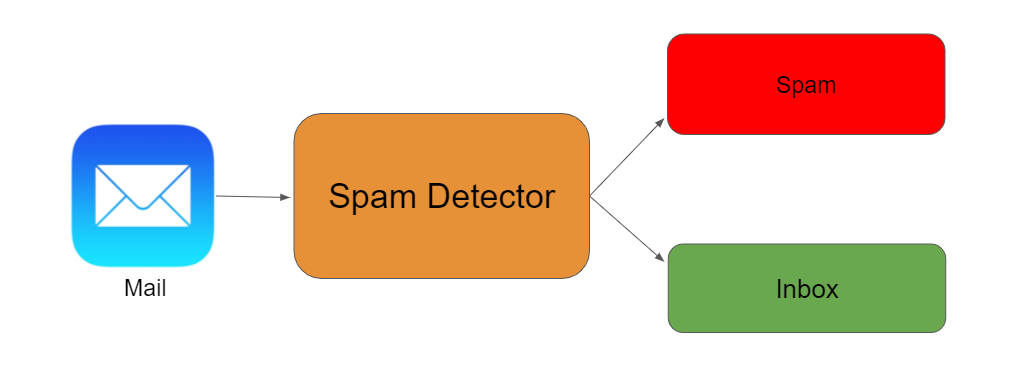
数据集 (Dataset)
Let’s start with our spam detection data. We’ll be using the open-source Spambase dataset from the UCI machine learning repository, a dataset that contains 5569 emails, of which 745 are spam.
让我们从垃圾邮件检测数据开始。 我们将使用UCI机器学习存储库中的开源Spambase数据集 ,该数据集包含5569封电子邮件,其中745 封为垃圾邮件。
The target variable for this dataset is ‘spam’ in which a spam email is mapped to 1 and anything else is mapped to 0. The target variable can be thought of as what you are trying to predict. In machine learning problems, the value of this variable will be modeled and predicted by other variables.
此数据集的目标变量是“垃圾邮件”,在该垃圾邮件中, 垃圾邮件被映射为1 ,其他任何内容都被映射为0。可以将目标变量视为您要预测的内容。 在机器学习问题中,此变量的值将由其他变量建模和预测。
A snapshot of the data is presented in figure 1.
数据快照如图1所示。
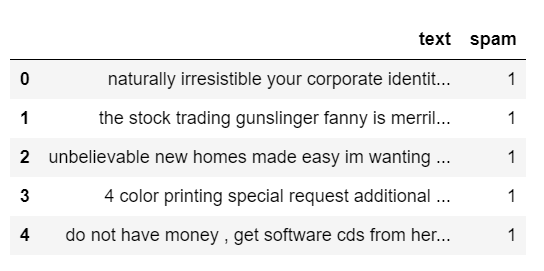
Task: To classify an email into the spam or not spam.
任务:将电子邮件分类为垃圾邮件还是非垃圾邮件。
To get to our solution we need to understand the four processing concepts below. Please note that the concepts discussed here can also be applied to other text classification problems.
为了获得我们的解决方案,我们需要了解以下四个处理概念。 请注意,此处讨论的概念也可以应用于其他文本分类问题。
- Text Processing 文字处理
- Text Sequencing 文字排序
- Model Selection 选型
- Implementation 实作

1.文字处理 (1. Text Processing)
Data usually comes from a variety of sources and often in different formats. For this reason, transforming your raw data is essential. However, this transformation is not a simple process, as text data often contain redundant and repetitive words. This means that processing the text data is the first step in our solution.
数据通常来自各种来源,并且通常采用不同的格式。 因此,转换原始数据至关重要。 但是,这种转换不是一个简单的过程,因为文本数据通常包含冗余和重复的单词。 这意味着处理文本数据是我们解决方案的第一步。
The fundamental steps involved in text preprocessing are
文本预处理涉及的基本步骤是
A. Cleaning the raw dataB. Tokenizing the cleaned data
A.清理原始数据B. 标记清理的数据
A.清理原始数据 (A. Cleaning the Raw Data)
This phase involves the deletion of words or characters that do not add value to the meaning of the text. Some of the standard cleaning steps are listed below:
此阶段涉及删除不会增加文字含义价值的单词或字符。 下面列出了一些标准的清洁步骤:
- Lowering case 小写
- Removal of special characters 删除特殊字符
- Removal of stopwords 删除停用词
- Removal of hyperlinks 删除超链接
- Removal of numbers 删除号码
- Removal of whitespaces 删除空格
小写 (Lowering Case)
Lowering the case of text is essential for the following reasons:
出于以下原因,减少文本的大小写是必不可少的:
- The words, ‘TEXT’, ‘Text’, ‘text’ all add the same value to a sentence 单词“ TEXT”,“ Text”,“ text”都为句子添加了相同的值
- Lowering the case of all the words is very helpful for reducing the dimensions by decreasing the size of the vocabulary 减少所有单词的大小写对于通过减小词汇量来减小维度非常有帮助
def to_lower(word):
result = word.lower()
return result删除特殊字符 (Removal of special characters)
This is another text processing technique that will help to treat words like ‘hurray’ and ‘hurray!’ in the same way.
这是另一种文本处理技术,将有助于处理“ hurray”和“ hurray!”之类的单词。 以同样的方式。
def remove_special_characters(word):
result=
word.translate(str.maketrans(dict.fromkeys(string.punctuation)))
return result去除停用词 (Removal of stop words)
Stopwords are commonly occurring words in a language like ‘the’, ‘a’, and so on. Most of the time they can be removed from the text because they don’t provide valuable information.
停用词是常见的单词,如“ the”,“ a”等语言。 大多数情况下,由于它们不提供有价值的信息,因此可以将其从文本中删除。
def remove_stop_words(words):
result = [i for i in words if i not in ENGLISH_STOP_WORDS]
return result删除超链接 (Removal of hyperlinks)
Next, we remove any URLs in the data. There is a good chance that email will have some URLs in it. We don’t need them for our further analysis as they do not add any value to the results.
接下来,我们删除数据中的所有URL。 电子邮件很有可能会包含一些URL。 我们不需要它们进行进一步的分析,因为它们不会为结果增加任何价值。
def remove_hyperlink(word):
return re.sub(r"http\S+", "", word)For more details on text preprocessing techniques, check out the article below.
有关文本预处理技术的更多详细信息,请查看下面的文章。
B.标记清理数据 (B. Tokenizing the Cleaned Data)
Tokenization is the process of splitting text into smaller chunks, called tokens. Each token is an input to the machine learning algorithm as a feature.
令牌化是将文本分成较小的块(称为令牌)的过程。 每个标记都是作为功能向机器学习算法输入的。
keras.preprocessing.text.Tokenizer is a utility function that tokenizes a text into tokens while keeping only the words that occur the most in the text corpus. When we tokenize the text, we end up with a massive dictionary of words, and they won’t all be essential. We can set ‘max_features’ to select the top frequent words that we want to consider.
keras.preprocessing.text.Tokenizer是一个实用程序功能,可将文本标记为标记,同时仅保留文本语料库中出现keras.preprocessing.text.Tokenizer的单词。 当我们标记文本时,我们最终得到了一个庞大的单词词典,它们并不是必不可少的。 我们可以设置' max_features '来选择我们要考虑的最常见的单词。
max_feature = 50000 #number of unique words to considerfrom keras.preprocessing.text import Tokenizer
tokenizer = Tokenizer(num_words=max_feature)
tokenizer.fit_on_texts(x_train)
x_train_features = np.array(tokenizer.texts_to_sequences(x_train))
x_test_features = np.array(tokenizer.texts_to_sequences(x_test))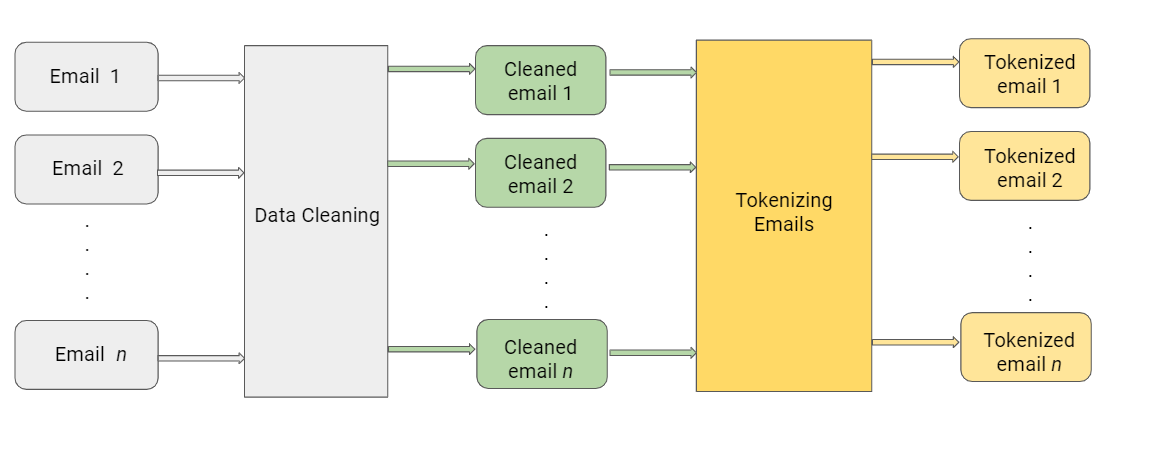

2.文本排序 (2. Text Sequencing)
一个。 填充 (a. Padding)
Making the tokens for all emails an equal size is called padding.
使所有电子邮件的令牌大小相等称为填充 。
We send input in batches of data points. Information might be lost when inputs are of different sizes. So, we make them the same size using padding, and that eases batch updates.
我们分批发送输入数据点。 当输入大小不同时,信息可能会丢失。 因此,我们使用填充使它们具有相同的大小,从而简化了批量更新。
The length of all tokenized emails post-padding is set using ‘max_len’.
填充后所有标记的电子邮件的长度是使用“ max_len ”设置的。
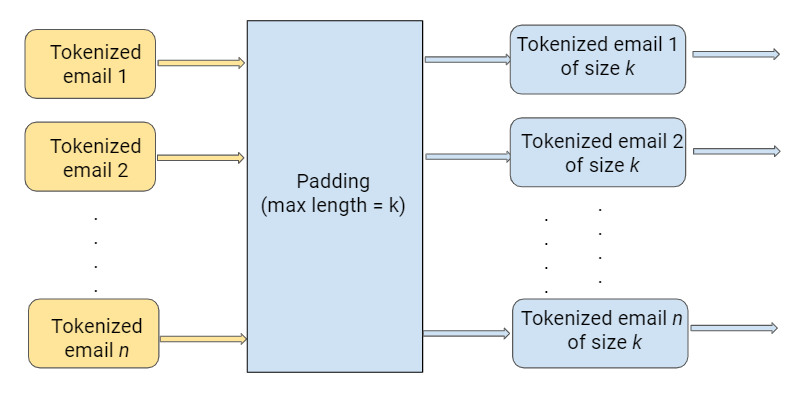
Code snippet for padding :
用于填充的代码段:
from keras.preprocessing.sequence import pad_sequences
x_train_features = pad_sequences(x_train_features,maxlen=max_len)
x_test_features = pad_sequences(x_test_features,maxlen=max_len)b。 标记编码目标变量 (b. Label the encoding target variable)
The model will expect the target variable as a number and not a string. We can use a Label encoder from sklearn, to convert our target variable as below.
模型将期望目标变量为数字而不是字符串。 我们可以使用sklearn,的Label编码器, sklearn,转换目标变量。
from sklearn.preprocessing import LabelEncoder
le = LabelEncoder()
train_y = le.fit_transform(target_train.values)
test_y = le.transform(target_test.values)
3.选型 (3. Model Selection)
A movie consists of a sequence of scenes. When we watch a particular scene, we don’t try to understand it in isolation, but rather in connection with previous scenes. In a similar fashion, a machine learning model has to understand the text by utilizing already-learned text, just like in a human neural network.
电影由一系列场景组成。 当我们观看一个特定的场景时,我们并不是试图孤立地理解它,而是与先前的场景联系起来。 就像在人类神经网络中一样,机器学习模型也必须通过利用已经学习的文本来理解文本。
In traditional machine learning models, we cannot store a model’s previous stages. However, Recurrent Neural Networks (commonly called RNN) can do this for us. Let’s take a closer look at RNNs below.
在传统的机器学习模型中,我们无法存储模型的先前阶段。 但是,递归神经网络(通常称为RNN)可以为我们做到这一点。 让我们仔细看看下面的RNN。
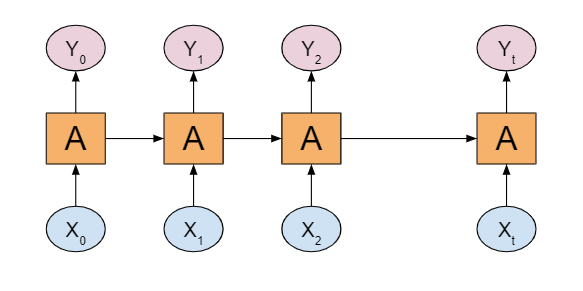
An RNN has a repeating module that takes input from the previous stage and gives its output as input to the next stage. However, in RNNs we can only retain information from the most recent stage. To learn long-term dependencies, our network needs memorization power. Here’s where Long Short Term Memory Networks (LSTMs) come to the rescue.
RNN具有一个重复模块,该模块接收来自上一级的输入,并将其输出作为输入提供给下一级。 但是,在RNN中,我们只能保留最近阶段的信息。 要了解长期依赖性,我们的网络需要记忆能力。 这就是抢救长期短期记忆网络(LSTM)的地方。
LSTMs are a special case of RNNs, They have the same chain-like structure as RNNs, but with a different repeating module structure.
LSTM是RNN的特例,它们具有与RNN相同的链状结构,但具有不同的重复模块结构。
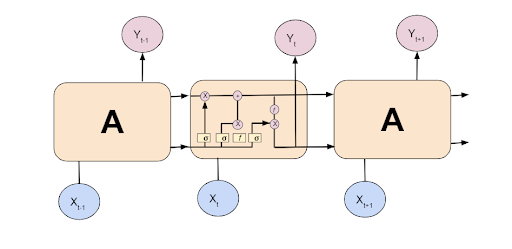
To perform LSTM even in reverse order, we’ll use a Bi-directional LSTM.
为了以相反的顺序执行LSTM,我们将使用双向LSTM。

4.实施 (4. Implementation)
嵌入 (Embedding)
Text data can be easily interpreted by humans. But for machines, reading and analyzing is a very complex task. To accomplish this task, we need to convert our text into a machine-understandable format.
文本数据很容易被人解释。 但是对于机器而言,读取和分析是一项非常复杂的任务。 为了完成此任务,我们需要将文本转换为机器可理解的格式。
Embedding is the process of converting formatted text data into numerical values/vectors which a machine can interpret.
嵌入是将格式化的文本数据转换为机器可以解释的数值/向量的过程。
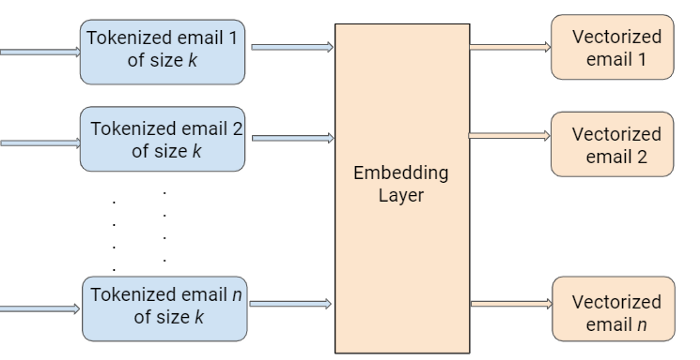
import tensorflow as tf
from keras.layers import Dense,LSTM, Embedding, Dropout, Activation, Bidirectional#size of the output vector from each layer
embedding_vector_length = 32#Creating a sequential model
model = tf.keras.Sequential()#Creating an embedding layer to vectorize
model.add(Embedding(max_feature, embedding_vector_length, input_length=max_len))#Addding Bi-directional LSTM
model.add(Bidirectional(tf.keras.layers.LSTM(64)))#Relu allows converging quickly and allows backpropagation
model.add(Dense(16, activation='relu'))#Deep Learninng models can be overfit easily, to avoid this, we add randomization using drop out
model.add(Dropout(0.1))#Adding sigmoid activation function to normalize the output
model.add(Dense(1, activation='sigmoid'))model.compile(loss='binary_crossentropy', optimizer='adam', metrics=['accuracy'])print(model.summary())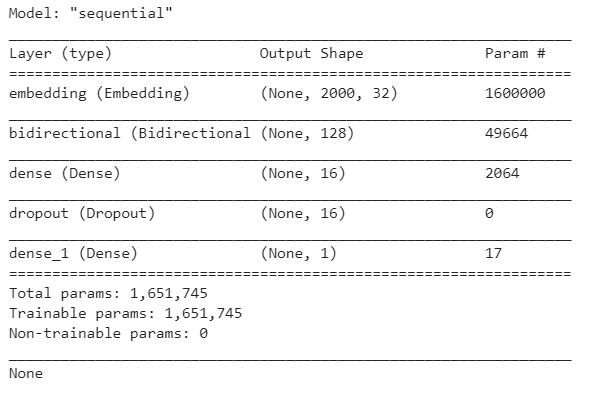
history = model.fit(x_train_features, train_y, batch_size=512, epochs=20, validation_data=(x_test_features, test_y))y_predict = [1 if o>0.5 else 0 for o in model.predict(x_test_features)]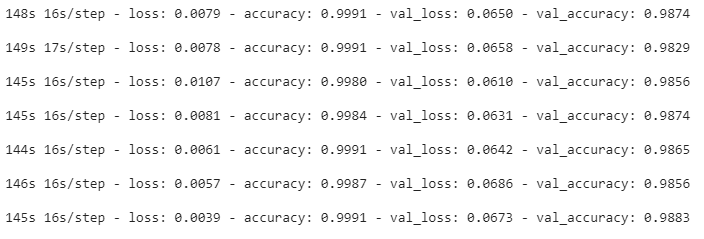
Through the above, we have successfully fit a bi-directional LSTM model on our email data and detected 125 of 1114 emails as spam.
通过以上操作,我们已经成功地在电子邮件数据上建立了双向LSTM模型,并检测到1114封电子邮件中有125封为垃圾邮件。
Since the percentage of spam in data is often low, Measuring the model’s performance by accuracy alone is not recommended. We need to evaluate it using other performance metrics as well, which we’ll look at below.
由于垃圾邮件在数据中的百分比通常较低,因此不建议仅通过准确性来衡量模型的性能。 我们还需要使用其他性能指标对其进行评估,我们将在下面进行介绍。

性能指标 (Performance Metrics)
Precision and recall are the two most widely used performance metrics for a classification problem to get a better understanding of the problem. Precision is the fraction of the relevant instances from all the retrieved instances. Precision helps us to understand how useful the results are. The recall is the fraction of relevant instances from all the relevant instances. Recall helps us understand how complete the results are.
精度和召回率是分类问题中使用最广泛的两个性能指标,可以更好地理解该问题。 精度是所有检索到的实例中相关实例的分数。 精度可以帮助我们了解结果的实用性。 召回是所有相关实例中相关实例的一部分。 召回有助于我们了解结果的完整性。
The F1 Score is the harmonic mean of precision and recall.
F1分数是精确度和查全率的谐波平均值。
For example, consider that a search query results in 30 pages, of which 20 are relevant, but the results fail to display 40 other relevant results. In this case, the precision is 20/30, and recall is 20/60. Therefore, our F1 Score is 4/9.
例如,假设一个搜索查询的结果为30个页面,其中20个是相关的,但是该结果无法显示40个其他相关的结果。 在这种情况下,精度为20/30,召回率为20/60。 因此,我们的F1得分是4/9。
Using F1-score as a performance metric for spam detection problems is a good choice.
将F1分数用作垃圾邮件检测问题的性能指标是一个不错的选择。
from sklearn.metrics import confusion_matrix,f1_score, precision_score,recall_scorecf_matrix =confusion_matrix(test_y,y_predict)tn, fp, fn, tp = confusion_matrix(test_y,y_predict).ravel()print("Precision: {:.2f}%".format(100 * precision_score(test_y, y_predict)))
print("Recall: {:.2f}%".format(100 * recall_score(test_y, y_predict)))
print("F1 Score: {:.2f}%".format(100 * f1_score(test_y,y_predict)))
import seaborn as sns
import matplotlib.pyplot as pltax= plt.subplot()
#annot=True to annotate cells
sns.heatmap(cf_matrix, annot=True, ax = ax,cmap='Blues',fmt='');# labels, title and ticks
ax.set_xlabel('Predicted labels');
ax.set_ylabel('True labels');
ax.set_title('Confusion Matrix');
ax.xaxis.set_ticklabels(['Not Spam', 'Spam']); ax.yaxis.set_ticklabels(['Not Spam', 'Spam']);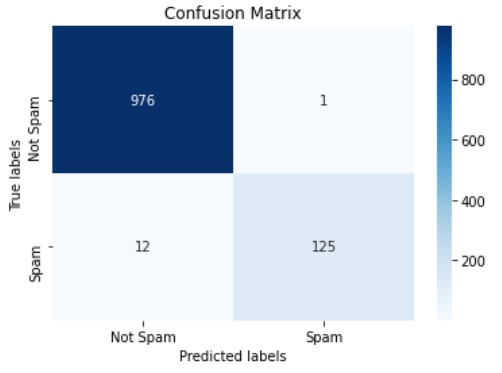
A model with an F1 score of 95% is a good-to-go model. Keep in mind, however, that these results are based on the training data we used. When applying a model like this to real-world data, we still need to actively monitor the model’s performance over time. We can also continue to improve the model by responding to results and feedback by doing things like adding features and removing misspelled words.
F1分数为95%的模型是不错的模型。 但是请记住,这些结果基于我们使用的训练数据。 在将这样的模型应用于实际数据时,我们仍然需要随着时间的推移积极地监视模型的性能。 我们还可以通过执行诸如添加功能和删除拼写错误的单词之类的结果来响应结果和反馈,从而继续改进模型。

摘要 (Summary)
In this article, we created a spam detection model by converting text data into vectors, creating a BiLSTM model, and fitting the model with the vectors. We also explored a variety of text processing techniques, text sequencing techniques, and deep learning models, namely RNN, LSTM, BiLSTM.
在本文中,我们通过将文本数据转换为向量,创建BiLSTM模型并使用向量对模型进行拟合来创建垃圾邮件检测模型。 我们还探索了多种文本处理技术,文本排序技术和深度学习模型,即RNN,LSTM,BiLSTM。
The concepts and techniques learned in this article can be applied to a variety of natural language processing problems like building chatbots, text summarization, language translation models.
本文中学到的概念和技术可以应用于各种自然语言处理问题,例如构建聊天机器人,文本摘要,语言翻译模型。

If you would like to experiment with the custom dataset yourself, you can download the annotated data on UCI machine learning repository and the code at Github. This article is originally published on Lionbridge.ai.
如果您想自己尝试使用自定义数据集,则可以在UCI机器学习存储库上下载带注释的数据,并在Github上下载代码。 本文最初在Lionbridge.ai上发布。
Thanks for the read. I am going to write more beginner-friendly posts in the future too. Follow me up on Medium to be informed about them. I welcome feedback and can be reached out on Twitter ramya_vidiyala and LinkedIn RamyaVidiyala. Happy learning!
感谢您的阅读。 我将来也会写更多对初学者友好的文章。 跟我上Medium ,以了解有关它们的信息。 我欢迎您提供反馈,可以在Twitter ramya_vidiyala和LinkedIn RamyaVidiyala上与他们联系 。 学习愉快!
翻译自: https://towardsdatascience.com/spam-detection-in-emails-de0398ea3b48
正则表达式检测电子邮件







 本文介绍如何利用正则表达式进行电子邮件的垃圾邮件检测,探讨了这一技术在数据科学中的应用。
本文介绍如何利用正则表达式进行电子邮件的垃圾邮件检测,探讨了这一技术在数据科学中的应用。














 344
344

 被折叠的 条评论
为什么被折叠?
被折叠的 条评论
为什么被折叠?








